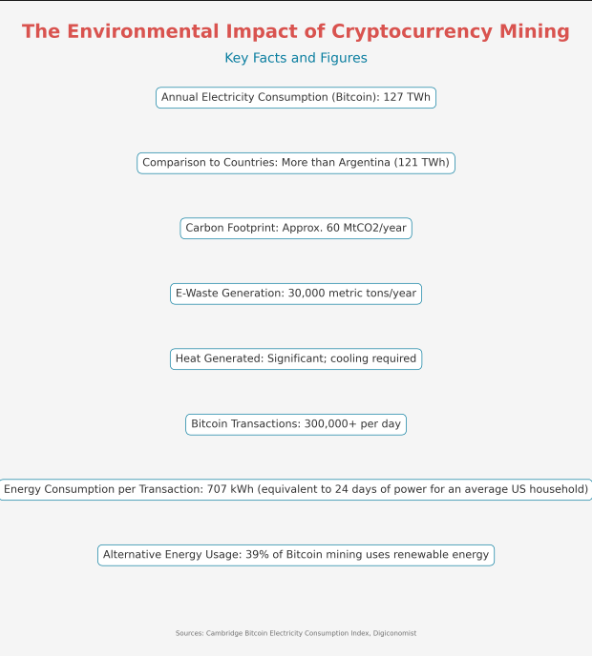Cryptocurrency mining has taken the world by storm, offering lucrative opportunities for investors and tech enthusiasts. However, the environmental cost of mining digital currencies like Bitcoin, Ethereum, and others has become a significant concern.
What Is Cryptocurrency Mining?
Cryptocurrency mining is the process by which new coins are created and transactions are verified on a blockchain network. This involves solving complex mathematical problems using powerful computers, a process that requires significant computational power and, consequently, vast amounts of electricity.
The Environmental Impact

- Energy Consumption
– High electricity demand: Cryptocurrency mining operations consume enormous amounts of electricity. Bitcoin mining alone consumes more energy annually than entire countries like Argentina or Norway. This high energy demand is primarily due to the intensive computational processes required for mining.
– Carbon footprint: Much of the electricity used in mining comes from non-renewable sources like coal and natural gas, contributing to high levels of carbon emissions. The carbon footprint of Bitcoin mining is comparable to that of large-scale industrial activities.
- Electronic Waste
– Hardware disposal: Cryptocurrency mining requires specialized hardware, such as ASIC (Application-Specific Integrated Circuit) miners. These devices have a limited lifespan and quickly become obsolete as mining difficulty increases. The disposal of outdated hardware contributes to the growing problem of electronic waste (e-waste).
– Toxic components: Mining hardware contains toxic materials like lead and mercury, which can leach into the environment if not properly disposed of, causing soil and water pollution.
- Water consumption
– Cooling systems: Mining operations generate significant heat, requiring effective cooling systems to prevent overheating. Many large-scale mining farms use water-based cooling, leading to substantial water consumption and, in some cases, local water shortages.
Examples from around the country:
- China’s Bitcoin mining ban
– China, once home to the majority of the world’s Bitcoin mining operations, imposed a ban on mining activities in 2021. One of the key reasons was the environmental impact, as mining was heavily reliant on coal-powered electricity.
Following the ban, many miners relocated to countries with cheaper energy costs, such as Kazakhstan and the United States, particularly in regions with less stringent environmental regulations.
- Iceland and renewable energy
– Iceland has become a popular destination for cryptocurrency mining due to its abundant renewable energy resources, such as geothermal and hydroelectric power. This has helped mitigate the environmental impact to some extent.
Despite using renewable energy, the high concentration of mining operations in Iceland has raised concerns about the strain on the local power grid and potential environmental impacts on geothermal resources.
- Texas and energy demand
– Texas has emerged as a major hub for cryptocurrency mining due to its deregulated energy market and relatively low electricity costs. However, the influx of mining operations has significantly increased energy demand, leading to concerns about grid stability and higher carbon emissions from fossil fuel-based power plants.
Mitigating the Environmental Impact
1.Transition to renewable energy
Encouraging the use of renewable energy sources for mining can significantly reduce the carbon footprint. For example, some companies are setting up mining farms powered by solar, wind, or hydroelectric energy.
2.Stricter regulations: Governments can implement regulations to limit the environmental impact of mining. This could include mandating the use of renewable energy, setting energy consumption caps, and enforcing proper e-waste disposal practices.
Cryptocurrency mining has undeniable environmental implications, primarily due to its high energy consumption and electronic waste generation. However, with the right combination of renewable energy adoption, regulatory measures, technological advancements, and community responsibility, it is possible to mitigate these impacts. As the world continues to embrace digital currencies, it is crucial to prioritize sustainability to ensure a greener and more environmentally friendly future for cryptocurrency mining.




